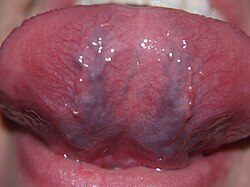The tongue is a muscular hydrostat on the floors of the mouths of most vertebrates which manipulates foodmastication. It is the primary organ of taste, as much of the upper surface of the tongue is covered in papillae and taste buds. It is sensitive and kept moist by saliva, and is richly supplied with nerves and blood vessels. In humans a secondary function of the tongue is phonetic articulation. The tongue also serves as a natural means of cleaning one's teeth. for
Musculature
The eight muscles of the human tongue are classified as either intrinsic or extrinsic. The four intrinsic muscles act to change the shape of the tongue, and are not attached to any bone. The four extrinsic muscles act to change the position the tongue, and are anchored to bone.
Intrinsic muscles
- Superior longitudinal fibers: shorten the tongue.
- Inferior longitudinal fibers: shorten the tongue.
- Vertical fibers: flatten and widen the tongue.
- Transverse fibers: narrow and elongate the tongue.
Extrinsic muscles

The receptors for taste, called taste buds,are situated chiefly in the tongue, but they are also located in the roof of the mouth and near the pharynx. They are able to detect four basic tastes: salty, sweet, bitter, and sour. The tongue also can detect a sensation called "umami" from taste receptors sensitive to amino acids. Generally, the taste buds close to the tip of the tongue are sensitive to sweet tastes, whereas those in the back of the tongue are sensitive to bitter tastes. The taste buds on top and on the side of the tongue are sensitive to salty and sour tastes. At the base of each taste bud there is a nerve that sends the sensations to the brain. The sense of taste functions in coordination with the sense of smell. The number of taste buds varies substantially from individual to individual, but greater numbers increase sensitivity. Women, in general, have a greater number of taste buds than men. As in the case of color blindness, some people are insensitive to some tastes.
The underside of a human tongue,
There is also secondary blood supply to the tongue from the tonsillar branch of the facial artery and the ascending pharyngeal artery.
Nerve supply
Taste for the anterior 2/3 of the tongue is supplied by the Facial nerve (Chorda tympani, CN7). General sensation of the anterior 2/3 is supplied by the Lingual nerve which is a branch of V3 of the Trigeminal nerve CN V.Taste as well as general sensation for the posterior 1/3 is supplied by the Glossopharyngeal nerve (CN 9).
All intrinsic and extrinsic muscles of the tongue are supplied by the Hypoglossal nerve (CN 12), except for one of the extinsic muscles, palatoglossus, which is inervated by CN10 of the pharyngeal plexus.




I found your blog very useful and informative especially that I'm doing some research now about science. Thank you for sharing this. Keep it up.
ReplyDeleteShella
www.gofastek.com